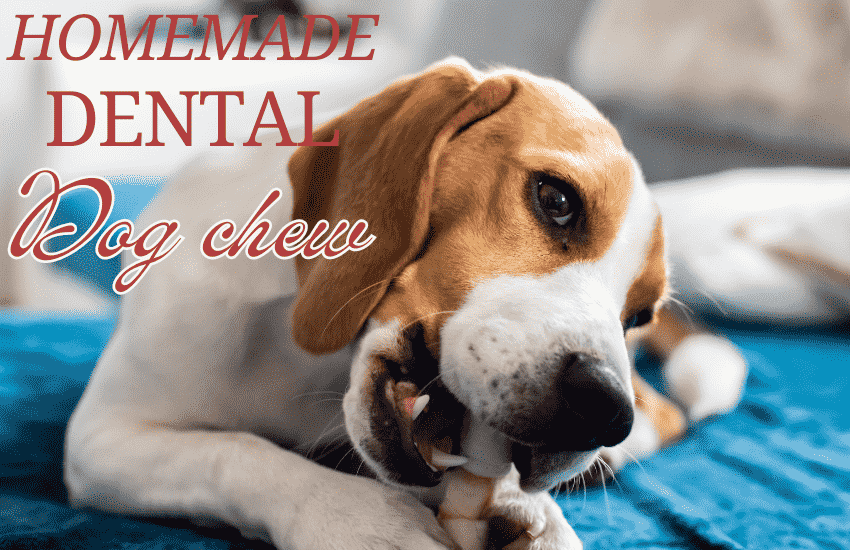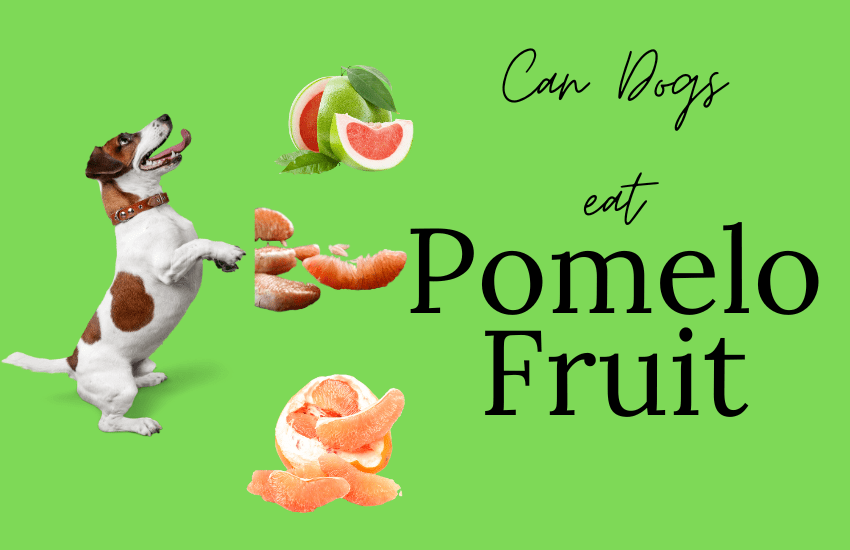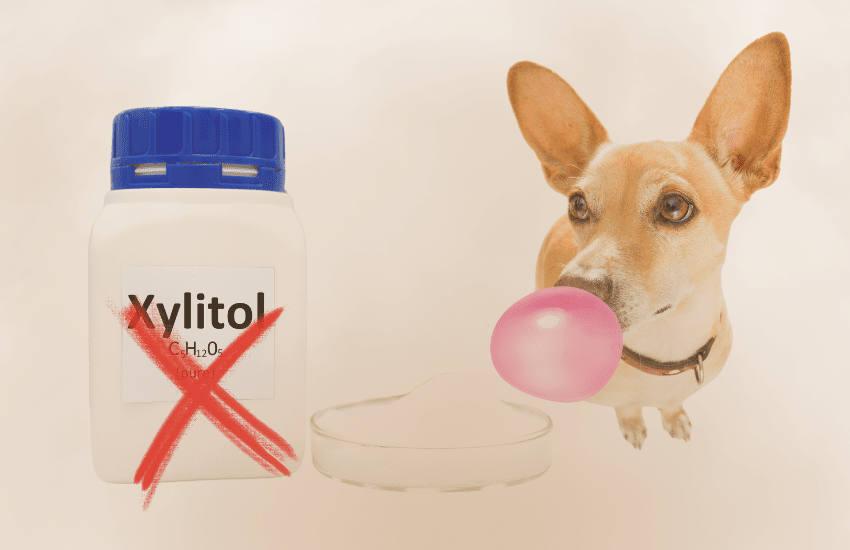Homemade dental chews for dogs can help maintain oral health and control tartar. They’re a cost-effective alternative to store-bought options.
Crafting homemade dental chews for your canine companion offers a wealth of benefits, both for their dental health and your peace of mind. By choosing to make these chews yourself, you gain control over the ingredients, ensuring that your pet avoids the preservatives and additives found in some commercial products.
These chews not only support strong teeth and gums but also provide a satisfying, chewy activity that dogs instinctively crave. Tailoring the recipe to your dog’s dietary needs and preferences can also be a fun and rewarding process, contributing to the overall well-being of your furry friend. With the right ingredients and a simple recipe, you can create a batch of healthy, effective dental chews that your dog will love.
Benefits Of Homemade Dental Chews
Homemade dental chews for dogs are a fantastic way to keep your furry friend’s teeth clean and their breath fresh. Not only do they help in removing plaque and tartar, but they also provide a healthy snack for your pet. By making them at home, you control the ingredients, ensuring your dog gets the best. These chews offer numerous benefits, from better oral health to personalized taste.
Natural Ingredients
One of the top benefits of homemade dental chews is the use of natural ingredients. Unlike store-bought options, you can avoid artificial colors, flavors, and preservatives. This means your dog enjoys a treat that’s not only effective at cleaning teeth but also safe and wholesome. Natural ingredients can include:
- Coconut oil: Known for its antimicrobial properties.
- Parsley: Freshens breath naturally.
- Whole grains: Provide dietary fiber for digestive health.
Using natural ingredients also reduces the risk of allergies and sensitivities. You can tailor the recipe to your dog’s specific needs. Here’s a simple comparison:
| Homemade Chews | Store-Bought Chews |
|---|---|
| Full control over what goes in | Potential unknown additives |
| No artificial preservatives | Often contain preservatives to extend shelf life |
Customizable Flavors
Another benefit is the ability to create customizable flavors that your dog loves. You know your pet’s preferences best. Whether they adore peanut butter or go crazy for chicken, you can craft the perfect chew. This can lead to better dental health, as dogs are more likely to chew thoroughly when they enjoy the taste. Consider these popular flavors:
- Peanut butter: A classic favorite among canines.
- Beef or chicken broth: Adds a savory taste.
- Mint: For a fresher breath.
Custom flavors mean more excitement for your dog every time they get a dental chew. It’s also a great way to introduce variety into their diet. Check out this flavor guide:
| Flavor | Benefits |
|---|---|
| Peanut butter | High in protein and a taste most dogs love |
| Beef broth | Rich flavor that entices dogs to chew |
| Mint | Natural breath freshener |
Common Ingredients For Homemade Dental Chews
Dogs love treats, and homemade dental chews are a great way to keep their teeth clean and breath fresh. Using the right ingredients is key. Let’s explore some common ones that are both safe and effective for your furry friend’s dental health.
Oat Flour
Oat flour is a fantastic base for homemade dog chews. It’s gluten-free and full of nutrients like fiber, which helps with digestion. Below are reasons why oat flour is a top choice:
- Safe for dogs with wheat allergies
- Helps create a perfect chewy texture
- Easy to digest
- Supports a healthy coat and skin
When making chews, mix oat flour with water until you get a dough-like consistency. Add flavor with safe ingredients like pureed pumpkin or chicken broth for a tasty chew.
Coconut Oil
Coconut oil is a super ingredient in dog chews. It not only helps the dough stick together but also boosts your dog’s health. Here’s why coconut oil is a must-have:
- It has antibacterial properties that promote oral health
- Improves coat shine and skin health
- Helps freshen breath
- Can improve digestive and metabolic function
Just a spoonful of coconut oil can make a big difference. It makes the chews tasty and helps clean your dog’s teeth as they gnaw away.
Parsley And Mint
Parsley and mint are more than just garnishes; they’re breath-freshening powerhouses for dental chews. These herbs have natural deodorizing properties. Check out their benefits:
- Parsley is rich in vitamins and reduces bad breath
- Mint has a strong, fresh scent that masks bad odors
Chop these herbs finely and mix them into your dough. They’ll give your dog’s breath a fresh scent and provide extra nutrition. Your pup’s kisses will be even sweeter!
Choosing The Right Ingredients
Making Homemade Dental Chews for Dogs is fun and healthy. The key? Choosing the Right Ingredients. Let’s find out how to pick them carefully.
Avoiding Harmful Additives
When making dental chews, avoiding bad stuff is crucial. Some ingredients seem okay but are not. Here’s what to steer clear of:
- Artificial colors: They make food look nice but can be risky.
- Excess salt: A little is okay, but too much is bad for dogs.
- Sugar and sweeteners: These can lead to weight gain and tooth decay.
Instead of harmful additives, use safe and natural ingredients. Here are some good options:
| Ingredient | Benefits |
|---|---|
| Pumpkin | Good for digestion |
| Carrots | Helps clean teeth naturally |
| Parsley | Freshens breath |
Remember, what you leave out is as important as what you put in.

Consideration For Dog’s Health Needs
Every dog is unique. Their dental chews should be too. Consider their health needs when choosing ingredients. For example:
- Allergies: Avoid ingredients that cause reactions.
- Age: Older dogs might need softer chews.
- Size: Big dogs need bigger chews than little ones.
Here’s a guide to picking ingredients based on health needs:
| Health Need | Ingredient | Why It’s Good |
|---|---|---|
| Joint Health | Turmeric | Reduces inflammation |
| Weight Control | Apple | Low calorie, high fiber |
| Digestive Health | Ginger | Soothes stomachs |
Choose ingredients that match your dog’s needs. This way, you’re not just cleaning their teeth. You’re boosting their health too!
Preparation And Recipes
Homemade dental chews for dogs keep their teeth clean and freshen their breath. Making these treats at home lets you control the ingredients, ensuring they’re healthy for your pet. The preparation is straightforward, and you can customize recipes to fit your dog’s taste and dietary needs. Below, find a simple recipe and learn how to adjust it for any dog size.
Simple Diy Dental Chew Recipe
Start with a basic recipe to make homemade dental chews that your dog will love. Gather these ingredients:
- 1 cup of brown rice flour
- 2 tablespoons of coconut oil
- 1 tablespoon of parsley
- 1/2 cup of low-sodium chicken broth
Now, follow these steps:
- Preheat your oven to 350°F (175°C).
- Mix the brown rice flour and parsley in a bowl.
- Add the coconut oil and chicken broth to create a dough.
- Roll the dough to 1/4 inch thickness on a floured surface.
- Cut into shapes with a cookie cutter.
- Place on a baking sheet lined with parchment paper.
- Bake for 30 minutes until golden brown.
Let them cool before serving to your dog. These chews can help scrape away plaque and massage the gums.
Variations For Different Dog Sizes
Adjust the size and hardness of the dental chews based on your dog’s size. Small dogs need smaller, softer chews, while large dogs can handle bigger, tougher ones. consider adding a bit more broth to the dough to make it softer.
For large dogs, include a tablespoon of ground flaxseed to make the chews tougher and more durable. Always observe your dog the first time they try a new chew to ensure they can handle it without choking. With these simple tweaks, you can make the perfect dental chew for any dog, keeping their teeth clean and their tails wagging.
Techniques For Dental Health Promotion
Homemade dental chews for dogs are a great way to keep your furry friend’s teeth clean and healthy. These chews help remove plaque and tartar build-up, freshen breath, and promote overall dental health. Making them at home allows you to control the ingredients, ensuring they are natural and safe for your dog. It’s important to use techniques that enhance dental health without risking your dog’s safety.
Proper Chew Size And Texture
Choosing the right size and texture for homemade dental chews is crucial. Chews that are too hard can damage teeth, while those that are too soft may not be effective at cleaning. Here are key points to consider:
- Size: The chew should be large enough to encourage chewing but not so big that it poses a choking hazard.
- Texture: It should be firm but have some give to it, to help scrape away plaque.
- Ingredients: Use digestible and dog-friendly ingredients to ensure safety and health benefits.
Creating the perfect chew involves a balance of these elements. Here is a simple table to guide you:
| Dog Size | Chew Size | Texture |
|---|---|---|
| Small | 4-5 inches | Firm, pliable |
| Medium | 5-6 inches | Slightly tougher |
| Large | 6+ inches | Tough, durable |
Remember to test different textures to find what works best for your dog’s dental health.
Supervision And Monitoring
Always supervise your dog when they enjoy a homemade dental chew. This ensures they don’t swallow large pieces that could lead to choking or blockages. Here’s what to watch for:
- Chewing Behavior: Make sure your dog chews and doesn’t try to swallow the chew whole.
- Chew Condition: Inspect the chew regularly and discard it if it becomes small enough to swallow.
- Dog’s Reaction: Look out for signs of discomfort or difficulty chewing, which could indicate the chew is too hard.
Monitor your dog’s dental health by checking their teeth and gums regularly. Look for signs of improvement or any issues that may need a vet’s attention. Keep a close eye on your dog’s behavior with their chews to ensure they remain safe and healthy during their chewing sessions.
Introducing Dental Chews To Your Dog
Do you want to keep your dog’s teeth clean and healthy? Try homemade dental chews! These treats are great for your dog’s dental health. But, you should introduce them slowly. Let’s talk about how to do this right.
Gradual Introduction Process
Starting with homemade dental chews can be exciting. Yet, it’s essential to do it slowly. This helps your dog get used to them without issues. Here’s a simple way to start:
- Day 1: Show the chew to your dog. Let them sniff it. Don’t let them eat it yet.
- Day 2: Let your dog lick the chew for a minute.
- Day 3: Allow your dog to chew on it for 2-3 minutes. Watch them closely.
- Day 4-7: Increase chewing time by a few minutes each day.
By the end of the week, your dog should be comfortable with the dental chew. Keep an eye on them to make sure they chew it safely.
| Day | Action | Note |
|---|---|---|
| 1 | Show | Just for sniffing |
| 2 | Lick | One minute only |
| 3 | Chew | 2-3 minutes, under watch |
| 4-7 | Increase time | Gradually, each day |
Observing For Allergic Reactions
It’s also crucial to watch for signs of allergies. Here are some things to look for:
- Itchy skin – Your dog might scratch more than usual.
- Upset stomach – Look for signs like vomiting or diarrhea.
- Difficulty breathing – This is rare but serious. If you see this, call your vet right away.
If you notice any of these signs, stop giving the chews. Talk to your vet. They can help you figure out what’s going on. Remember, not all dogs react the same way to new foods. So, it’s better to be safe and watch how your dog reacts.
Here’s a quick checklist for allergy signs:
| Sign | What to Do |
|---|---|
| Itchy skin | Monitor, reduce frequency |
| Upset stomach | Stop chews, consult vet |
| Difficulty breathing | Stop chews, call vet immediately |
By following these steps, you can help your dog enjoy their new chews safely. Always keep an eye on them, and enjoy the journey to better dental health!
Frequency And Timing Of Dental Chew Use
Keeping your dog’s teeth clean is vital, and homemade dental chews are a great way to help. Knowing when and how often to give these chews is key. Stick to a routine to ensure your dog’s teeth stay healthy. Let’s explore the best practices for using homemade dental chews.
Incorporating Into Daily Routine
Making homemade dental chews part of your dog’s daily life is simple. Aim for consistency to maintain oral health. Here’s how to do it:
- Offer a chew after the morning walk. It helps clean teeth and keeps your dog busy.
- Use chews as a reward for good behavior. It promotes positive habits and dental care.
- Set a specific time each day for chews. Your dog will look forward to it!
Remember, balance is crucial. Too many chews can lead to weight gain. Stick to one chew per day for the best results. If your dog is small or less active, consider smaller portions.
Consideration For Meal Times
Homemade dental chews also affect your dog’s meal times. It’s important to consider this when planning their diet. Here are some tips:
- Give chews after meals to help remove food particles from their teeth.
- Avoid chews right before meals. Your dog might not eat their food if they’re not hungry.
- Monitor your dog’s calorie intake. Chews have calories, so adjust their meals accordingly.
Here’s a simple guide to follow for mealtime consideration:
- Feed your dog their regular meal.
- Wait for about 30 minutes.
- Offer the homemade dental chew as a post-meal treat.
This routine helps with digestion and ensures your dog still has an appetite for their main meals. Keep track of your dog’s reaction to the chews. Some dogs might need a different schedule. Be flexible and tailor the routine to your pet’s needs. This ensures they get the most from their homemade dental chews while keeping their diet balanced.
Monitoring Dental Health for your dog
Keeping your dog’s teeth clean is vital for their overall health. Homemade dental chews can help scrape off plaque. Yet, they are just one piece of the puzzle. It’s crucial to monitor your dog’s dental health regularly. Doing so prevents serious health issues. Let’s explore how you can keep track of your furry friend’s pearly whites.
Regular Veterinary Check-ups
Just like humans, dogs need regular dental check-ups. These visits are key to spotting problems early. A vet can provide a professional cleaning and check for issues. Here’s what you should know:
- Annual exams are a must. They help catch dental diseases before they worsen.
- Vets have special tools to remove tartar that chews can’t.
- They can also spot signs of gum disease and tooth decay.
It’s also useful to understand what a vet looks for during a check-up. Here’s a quick table:
| Check-Up Item | Importance |
|---|---|
| Gum Health | Indicates possible gingivitis or periodontitis |
| Tooth Stability | Loose teeth can signal advanced dental disease |
| Plaque and Tartar | Build-up can lead to serious health issues |
Remember, early detection leads to simpler treatments. Make sure your dog’s dental health is part of their regular vet visits.
Observing Changes In Dental Condition
Between vet visits, you can watch for dental health changes. Here’s what to look out for:
- Bad breath – a sign of bacteria build-up.
- Red or swollen gums – could indicate gingivitis.
- Difficulty eating – may reveal dental pain or loose teeth.
Chewing habits also offer clues. If your dog avoids their chew toys or seems painful when chewing, it’s a red flag. Use this guide to spot problems:
| Sign | Possible Issue | Action |
|---|---|---|
| Chewing on one side | Pain on the other side | Check for tooth damage |
| Dropping food | Loose teeth or sore gums | Inspect their mouth |
| Refusing to eat hard food | Sensitivity or pain | Offer soft food and visit the vet |
Stay alert to these changes. They can help you act quickly if your dog’s dental health is at risk. Combine homemade chews with regular monitoring for a happy, healthy dog.
Frequently Asked Questions
How To Make A Dog Dental Chew?
To make a dog dental chew, mix 1 cup of brown rice flour, 2 tablespoons of parsley, 1 tablespoon of activated charcoal, and 3/4 cup of water. Form into shapes and bake at 350°F for 30 minutes. Let them cool completely before serving to your dog.
What Is The Best Natural Thing For Dogs Teeth?
Chewing on raw bones is often considered the best natural teeth cleaner for dogs, helping to remove plaque and tartar buildup effectively.
What Can I Use Instead Of Dental Treats For Dogs?
For an alternative to dental treats for dogs, consider using raw carrots, dental chew toys, or specially-formulated dental care kibble to help maintain your dog’s oral health.
How Do I Make My Own Greenies?
To make homemade greenies, gather fresh ingredients like peas, mint, and parsley. Blend these with whole wheat flour and vegetable oil, shape into treats, and bake until crisp. Always consult a pet nutritionist to ensure your recipe is safe for your dog.
Conclusion
Crafting homemade dental chews is a delightful way to support your dog’s dental health. Embrace this wholesome approach, and enjoy the peace of mind that comes with providing natural, nourishing treats. Your furry friend’s tail-wagging smile will thank you for the love and care in every bite.
Start experimenting with recipes and watch your pup’s dental health shine!






